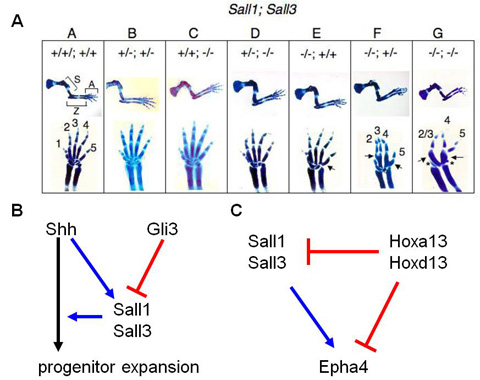
Yasuhiko Kawakami, Yukako Uchiyama, Concepcion Rodriguez Esteban, Toshiaki Inenaga, Naoko Koyano-Nakagawa, Hiroko Kawakami, Merce Marti, Marie Kmita, Paula Monaghan-Nichols, Ryuichi Nishinakamura, and Juan Carlos Izpisua Belmonte,Sall genes regulate region-specific morphogenesis in the mouse limb by modulating Hox activities. Development (2009) 136(4):585-594 .
The genetic mechanisms that regulate the complex morphogenesis of generating cartilage elements in correct positions with precise shapes during organogenesis, fundamental issues in developmental biology, are still not well understood. By focusing on the developing mouse limb, we confirm the importance of transcription factors encoded by the Sall gene family in proper limb morphogenesis, and further show that they have overlapping activities in regulating regional morphogenesis in the autopod. Sall1/Sall3 double null mutants exhibit a loss of digit1 as well as a loss or fusion of digit2 and digit3, metacarpals and carpals in the autopod. We show that Sall activity affects different pathways, including the Shh signaling pathway, as well as the Hox network. Shh signaling in the mesenchyme is partially impaired in the Sall mutant limbs. Additionally, our data suggest an antagonism between Sall1-Sall3 and Hoxa13-Hoxd13. We demonstrate that expression of Epha3 and Epha4 is downregulated in the Sall1/Sall3 double null mutants, and, conversely, is upregulated in Hoxa13 and Hoxd13 mutants. Moreover, the expression of Sall1 and Sall3 is upregulated in Hoxa13 and Hoxd13 mutants. Furthermore, by using DNA-binding assays, we show that Sall and Hox compete for a target sequence in the Epha4 upstream region. In conjunction with the Shh pathway, the antagonistic interaction between Hoxa13-Hoxd13 and Sall1-Sall3 in the developing limb may contribute to the fine-tuning of local Hox activity that leads to proper morphogenesis of each cartilage element of the vertebrate autopod.

Figure: A. Sall1/Sall3 knockout mice show defects in digit 1, 2, and 3.
B. Sall genes, which are controlled by Shh, are partially involved in the Shh signal. C. Sall genes, which are repressed by Hox genes, compete with Hox for Epha4.